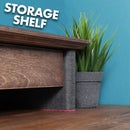Introduction: Zeo Bottle Flute Glass
I have an addiction to Zeo Zest (lime flavoured fizzy drink) and I keep all the empty bottles. They have a really nice design to them and I have been wanting to use them in a project. I decided to make one into a champagne style flute glass.
If you would sooner watch the process you can see my YouTube video here:
Materials Used:
- Glass Bottle
- Scrap Walnut Wood
- Milliput (Epoxy Putty)
- Wood Glue
Tools Used:
To Cut The Bottle:
- Glass Cutter
- Roll Of Tape (To help score a straight line)
- Candle
- Lighter
- Ice Cube
- Sand Paper
To Make The Walnut Base:
- Band Saw
- Mitre Saw
- Belt Sander
- Clamps
- Spray Lacquer
Step 1: Cutting the Glass Bottle
If you watched my video you will have seen i had a few failed attempts to get a clean cut. The only method I managed to get clean repeatable cuts from is this one...
I used a roll of tape to help keep the glass cutter steady. I placed the bottle inside the roll of tape and held the glass cutter firmly down on the edge of the tape. I could then turn the glass against the cutter and keep a consistent straight line.
Once the line was scored all the way around the bottle I needed to heat up that area. I used a candle as the heat source and I turned the glass over the flame. I made sure to keep the score line over the centre of the flame and kept turning the glass to evenly distribute the heat. There isn't an exact amount of time to do this for but I kept turning for about 40 seconds. I did start to hear some slight cracking but that doesn't always happen. I then quickly removed the bottle from the flame and cooled down the score line with an ice cube. You should see a crack make its way toward the inside of the bottle. The light will reflect off the surface of the crack so you should be able to see it clearly. If the crack has made it all the way through the bottle you can now separate the 2 pieces, if not just repeat the last 2 steps. Heat over the candle and cool with the ice. Eventual it will separate. If your score line was straight you should end up with a nice clean cut.
Then just use some sand paper the smooth out any rough or sharp areas on the cut edge. You don't want to cut your lip from a rough glass edge. Wet sand paper would work a lot better then the dry sand paper I used in the video.
Step 2: Create the Base
I love the grain and colour of Walnut so that's what I decided to use for the base of the glass. I also had some scrap pieces that would be ideal for this project.
I wanted a chunky base so I glued 2 pieces of 25mm thick walnut to create a 50mm thick piece. I used a band saw to roughly square up the blank and I used a belt sander to remove the marks from the band saw.
I then used a mitre saw to cut the wood to length. The finished dimensions were 50mm x 50mm x 70mm. These measurements are totally up to you though. It depends on the design your want to use and also the size of the bottle you used.
I wanted to add a simple taper to the base. I measured in 5mm from all sides on the top edge and drew a line from that point to the bottom corner. This gave me guide lines to work too. Because it is such a small taper I decided to use the belt sander to work to the line. It didn't take long at all.
Step 3: Fit the Bottle Top in the Base
The bottle top to the zeo bottle measured roughly 28mm. So I used a 30mm forstner bit to drill a hole in the base that I could fix the top into.
I kept checking the depth of the hole with the bottle top. I drill the hole deep enough that the top and threads from the bottle would be hidden.
I then needed to permanently fix the top into place. I always use Milliput which is an epoxy putty for these kind of jobs. It comes in 2 parts that you mix together equally and when it sets it is as hard as stone. It is designed to fix boilers and radiators so it is water proof and heat resistant. Perfect for this job.
I rolled the Milliput into a small ball and popped it in the bottom of the hole I had drilled. I then pushed the bottle top into the hole and cleaned up any Milliput that squeezed out around the sides. I checked to see if it was level and even around the edges and then left it to set over night.
Step 4: Finish
To finish the base I decided to use spray lacquer. I think a spray polyurethane would be a better choice for this application though.
I'm not worried about the base getting wet though because this is my favourite part of the design. Because I have fixed the bottle cap in place and not the glass itself, I can simple screw the glass into the base when I want to drink and unscrew the glass from the base when I need to wash the glass. So the wood has no need to come into contact with a lot of water. A quick wipe with a damp cloth should be more than enough to keep it clean. The glass of course can be washed the same way you would any other drinking glass.
I really hope you like this project and idea. I really enjoyed making it.













